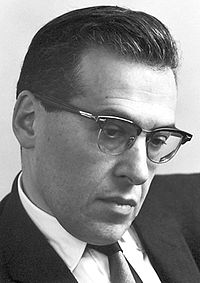人物簡介
 朱利安·施溫格
朱利安·施溫格20世紀20年代建立的處理電子與電磁輻射相互作用的量子場論成功地描述了原子內光的輻射和吸收、喇曼效應、康普頓效應、光電效應以及正負電子對的產生,但是,這種場論存在“發散”困難,即在許多計算中都會得到無窮大這一荒謬的結果。朝永振一郎(左圖)和施溫格(右圖)分別提出,要消除“發散”困難,就應該考慮電子的質量會因電子和場的相互作用而改變,必須進行“重整化”。“重整化”方法能夠很好地解釋蘭姆位移和電子的反常磁矩。
費恩曼(左圖)在研究量子力學基本問題的過程中,運用作用量的表現形式,建立了量子力學的路徑積分方法,並用它重新寫出了整個量子電動力學,使之具有相對論協變性。他把基本過程看作是粒子從一點到另一點的傳播,並用簡單圖形來描繪基本粒子之間的相互作用,這就是粒子物理學家十分熟悉的費恩曼圖。
費恩曼、施溫格和朝永振一郎彼此獨立地創建了物理學中也許是最近乎完美的理論,他們三人提出了各自獨特的想法,卻得出了一致的結論。他們提出的量子電動力學理論正確地描述了電子、光子及其相互作用,經受住了十分精確的實驗檢驗,成為描述電磁相互作用的基本理論。
人物經歷
施溫格出生於紐約,從小就表現出了驚人的物理天才和勤奮,在十六歲那年他就發表了他的第一篇物理論文。他起先在紐約市立學院上學,在著名物理學家拉比I.I.Rabi的關懷下,他轉學到了哥倫比亞大學。1939年,二十一歲的施溫格獲得了博士學位。
隨後的幾年他先後在伯克利加州大學任奧本海默的助手和任教於普度大學。
英語介紹
Julian Schwinger was born on 12th February 1918 in New York City. The principal direction of his life was fixed at an early age by an intense awareness of physics, and its study became an all-engrossingactivity. To judge by a first publication, he debuted as a professional physicist at the age of sixteen. He was allowed to progress rapidly through the public school system of New York City. Through the kind interest of some friends, and especially I.I. Rabi of Columbia University, he transferred to that institution, where he completed his college education. Although his thesis had been written some two or three years earlier, it was in 1939 that he received the Ph.D. degree.
For the next two years he was at the University of California, Berkeley, first as a National Research Fellow and then as assistant to J.R. Oppenheimer. The outbreak of the Pacific war found Schwinger as an Instructor, teaching elementary physics to engineering students at Purdue University.
War activities were largely confined to the Radiation Laboratory at the Massachusetts Institute of Technology in Cambridge. Being a confirmed solitary worker, he became the night research staff. More scientific influences were also at work. He first approached electromagnetic radar problems as a nuclear physicist, but soon began to think of nuclear physics in the language of electrical engineering. That would eventually emerge as the effective range formulation of nuclear scattering. Then, being conscious of the large microwave powers available, Schwinger began to think about electron accelerators, which led to the question of radiation by electrons in magnetic fields. In studying the latter problem he was reminded, at the classical level, that the reaction of the electron's field alters the properties of the particle, including its mass. This would be significant in the intensive developments of quantumelectrodynamics, which were soon to follow.
With the termination of the war Dr. Schwinger accepted an appointment as Associate Professor at Harvard University. Two years later he became full Professor. That was also the year of his marriage to ClariceCarrolof Boston.
In subsequent years, he worked in a number of directions, but there was a pattern of concentration on general theoretical questions rather than specific problems of immediate experimental concern, which were nearer to the center ot hls earlier work. A speculative approach to physics has its dangers, but it can have its rewards. Schwinger was particularly pleased by an anticipation, early in 1957, of the existence of two different neutrinos associated, respectively, with the electron and themuon. This has been confirmedexperimentallyonly rather recently. A related and somewhat earlier speculation, that all weak interactions are transmitted by heavy, charged, unit-spin particles still awaits a decisive experimental test. Schwinger's policy of finding theoretical virtues in experimentally unknown particles has culminated recently in a revived concern with magnetically charged particles, which may also be involved in the understanding of strong interactions.
In later years, Schwinger has followed his own advice about the practical importance of a phenomenological theory of particles. He has invented andsystematicallydeveloped source theory, which deals uniformly with strongly interacting particles, photons, and gravitons, thus providing a general approach to all physical phenomena. This work has been described in two volumes published under the title "Particles, Sources, and Fields".
Awards and other honors include the first Einstein Prize (1951), the U.S. National Medal of Science (1964), honorary D.Sc. degrees from Purdue University (1961) and Harvard University (1962), and the Nature of Light Award of the U.S. National Academy of Sciences (1949). Prof. Schwinger is a member of the latter body, and a sponsor of the Bulletin of the Atomic Scientists.
